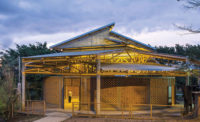Toledo, Spain
The design for a convention center in central Spain's historic city of Toledo presented Rafael Moneo with a fascinating problem: how to insert a modern, 400,000-square-foot building into a city that has scarcely changed since El Greco painted it in the 16th century.
The building forms part of a master plan developed by the Barcelona urbanist Joan Busquets in 1993, which sought to improve access to the hilltop core of this UNESCO World Heritage site and to promote new activities. Toledo was an important center under the Romans, Visigoths, and Moors, and was the capital of Catholic Spain for nearly 600 years before enduring centuries of decline. More recently, the regional government of Castile'La Mancha and a public university have occupied many of its historic buildings, bringing greater diversity but worsening traffic congestion. Busquets's plan included new parking areas at the hill's base, with escalators to the city above. Working with the planner, Moneo suggested moving the parking to the site of an unattractive existing garage, replacing the structure with a new building that also includes a conference facility originally planned for another site.
The center's outer wall replaces sections of old rubble walls, in poor condition and of no historical value. The excavation behind it accommodates five levels of parking for 600 cars and the convention center with a 1,000-seat auditorium, a multipurpose hall with a capacity for 500, a restaurant, and four smaller conference rooms, all topped by a terracelike roof that has become a popular evening attraction.
Moneo marks the entry to the building with a series of studied formal gestures that constitute his contemporary contribution to the urban fabric. A covered, porchlike plaza connects to the Paseo del Miradero via various ramps and stairs, including a pedestrian bridge that swoops out from the walls over the void below, supported by a sculptural, three-armed concrete pillar. Runs of escalators descend from the plaza along the inside face of the building's exterior wall to the street below, where they connect with a drop-off point for tour buses and to the main bus and train stations, located a few blocks away. The building thus functions as a key connector between transportation hubs and the city.
Moneo developed the project over 12 years, adjusting the design in response to severe cost restrictions and construction delays. Some of the center's weaknesses might be attributed to these factors, particularly the rough quality of the exposed concrete, whose defects are magnified by its yellowish pigmentation, which was selected to blend into the color palette of the city but remains jarring to the eye.
The main facade, which is highly visible when seen from below, is finished to resemble other sections of the city walls, although in broader, contemporary proportions, with horizontal strips of coarse granite stonework separated by bands of concrete. The surface is interrupted by the vertical piping of vents for the parking garage, which emulate the stone and brick buttresses of nearby retaining walls. The vents are another discordant presence, finished in concrete and arranged rather weakly at different heights and spacing. A more regular spacing, like that employed by the surrounding houses, might have been more convincing.
'We had to make many adjustments over many years, and worked with very limited resources,' says Moneo in response to these criticisms, while underscoring the relevance of his imitative approach. 'We were always clear about the basic strategy'and that is what's important. If the strategy is correct, everything that accompanies the project becomes secondary. And so it can be forgiven that the masonry is not strictly traditional, or its trimming is of concrete instead of brick.'
To what degree does Toledo's memorable cityscape depend on the quality of each of its individual buildings? Zeroing in with a critical eye on any one of the anonymous structures that make up most of the urban fabric, you may find it lacking in one way or another'a dubious modernization, a drab exterior finish. Likewise, the crude workmanship, jarring color, and busy entry structure of Moneo's design may strike a discordant note at first sight. But take a step back, and everything blends into a harmonious whole. Given time and familiarity, Moneo's convention center will certainly join in Toledo's forgiving accumulation of historical periods. As the architect explains, 'The building is there, but it is inconspicuous. It contributes to the life of the city, but it doesn't declare its presence.' But had he chosen to make it more decidedly of its own period, perhaps its contribution to Toledo's image would have been more positive'one of dialogue and encounter.
PeopleOwner: Ayuntamiento de Toledo
Architect:
Personnel in architect's firm who should receive special credit: Architect of record: Rafael Moneo Quantity surveyors: Vidal Gutiérrez de Sande, Gonzalo Romero, Francisco González Peiró
Engineer(s): Mechanical Engineer: Rafael Úrculo – R. Urculo Ingenieros Consultores
Consultant(s): General contractor: Acciona Photographer(s): Duccio Malagamba Gross square footage: 487,800 gross square feet (including parking and outdoor spaces) Total construction cost: $56 million Completion date: December 2012 |
Products
Structural system
Exterior cladding
Metal/glass curtain wall:
Curtain wall:
Other cladding unique to this project:
Windows
Metal frame:
Glazing
Doors
Metal doors:
Wood doors:
Hardware
Pulls:
Other special hardware:
Interior finishes
Cabinetwork and custom woodwork:
Paneling:
Furnishings
Lighting
Task lighting:
Dimming System or other lighting controls:
Conveyance |













Post a comment to this article
Report Abusive Comment